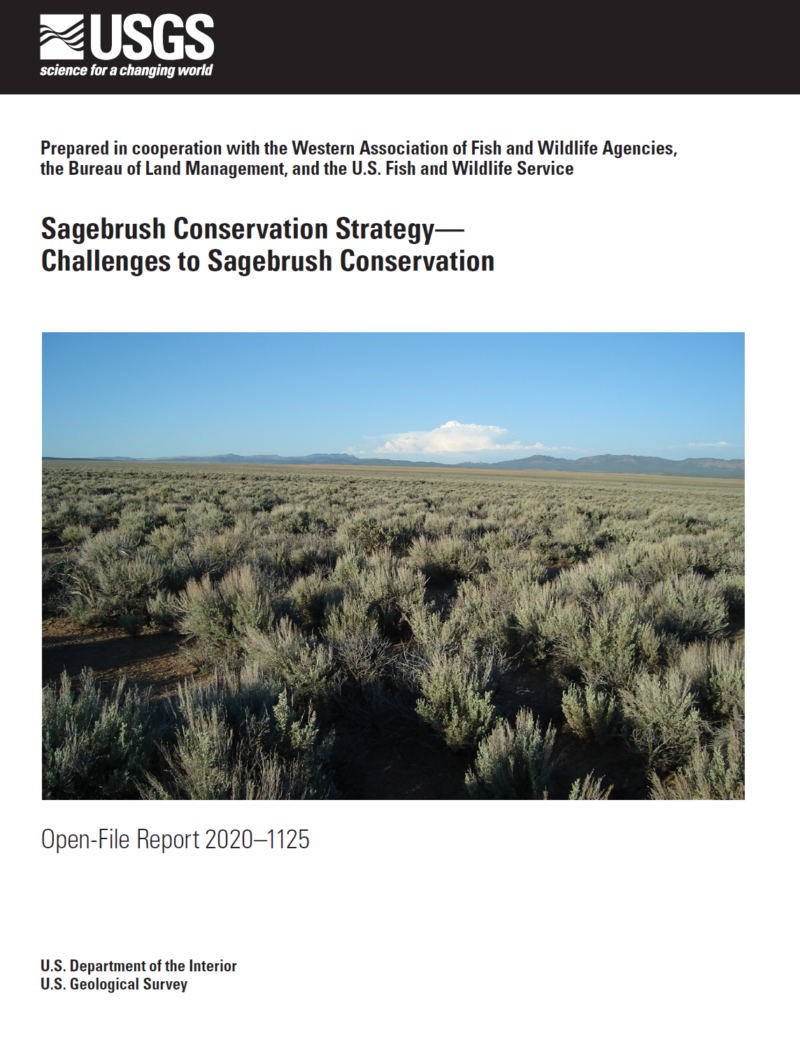Abstract
The sagebrush (Artemisia spp.) biome, its wildlife, and the services and benefits it provides people and local communities are at risk. Development in the sagebrush biome, for many purposes, has resulted in multiple and often cumulative negative impacts. These impacts, ranging from simple habitat loss to complex, interactive changes in ecosystem function, continue to accelerate even as the need grows for the resources provided by this biome. This “Sagebrush Conservation Strategy—Challenges to Sagebrush Conservation,” is an overview and assessment of the challenges facing land managers and landowners in conserving sagebrush ecosystems. This strategy is intended to provide guidance so that the unparalleled collaborative efforts to conserve the iconic greater sage-grouse (Centrocercus urophasianus) by State and Federal agencies, Tribes, academia, nongovernmental organizations, and stakeholders can be expanded to the entire sagebrush biome to benefit the people and wildlife that depend on this ecosystem. This report is organized into 3 parts.
“Part I. Importance of the Sagebrush Biome to People and Wildlife” introduces the biome and a subset of the more than 350 species of plants and animals associated with sagebrush for which there is some level of conservation concern. These include several sagebrush obligates that have been petitioned for listing under the Endangered Species Act of 1973 (16 U.S.C. 1531 et seq.), including greater sage-grouse, Gunnison sage-grouse (C. minimus; listed as threatened), and pygmy rabbit (Brachylagus idahoensis). Other sagebrush-dependent species, such as pronghorn (Antilocapra americana) and mule deer (Odocoileus hemionus), have experienced significant population declines.
“Part II. Change Agents in the Sagebrush Biome—Extent, Impacts, and Effort to Address Them” is an overview of the variety of change agents that are causing the continued loss and degradation of sagebrush. Topics covered include altered fire regimes, invasive plant species, conifer expansion, overabundant free-roaming equids, and human land uses, including energy development, cropland conversion, infrastructure, and improper livestock grazing. Climate changes, including warmer temperatures and altered amounts and timing of precipitation, have and will likely increasingly compound negative effects to sagebrush ecosystems from all these threats.
“Part III. Current Conservation Paradigm and Other Conservation Needs for Sagebrush” begins with an overview of how sage-grouse conservation, and the associated efforts and collaborations, may be able to address threats to and restoring degraded sagebrush and habitat for other sagebrush-dependent and -associated species. Meeting conservation goals for sage-grouse, mule deer, pygmy rabbits, and other sagebrush-associated wildlife will require extensive restoration of sagebrush communities already converted or degraded by the change agents outlined in Part II of this report. Concepts, considerations, techniques for restoration, and adaptive management and monitoring are discussed to help set the stage for potential strategies to improve conditions throughout the sagebrush biome. Communication, outreach, and engagement can enhance grassroots conservation efforts and build the next generation of managers, practitioners, scientists, and communicators who will care for the sagebrush ecosystem and stimulate or sustain public participation in sagebrush conservation issues.
Suggested Citation
Remington, T.E., Deibert, P.A., Hanser, S.E., Davis, D.M., Robb, L.A., and Welty, J.L., 2021, Sagebrush conservation strategy—Challenges to sagebrush conservation: U.S. Geological Survey Open-File Report 2020–1125, 327 p.
Attached Files
| File | Action |
|---|---|
| Sagebrush Conservation Strategy.pdf | Download |
- Version
- File Type pdf
- File Size 111.89 MB
- Publication Date March 11, 2021
- Download Count [8177]
- View Count [203]
